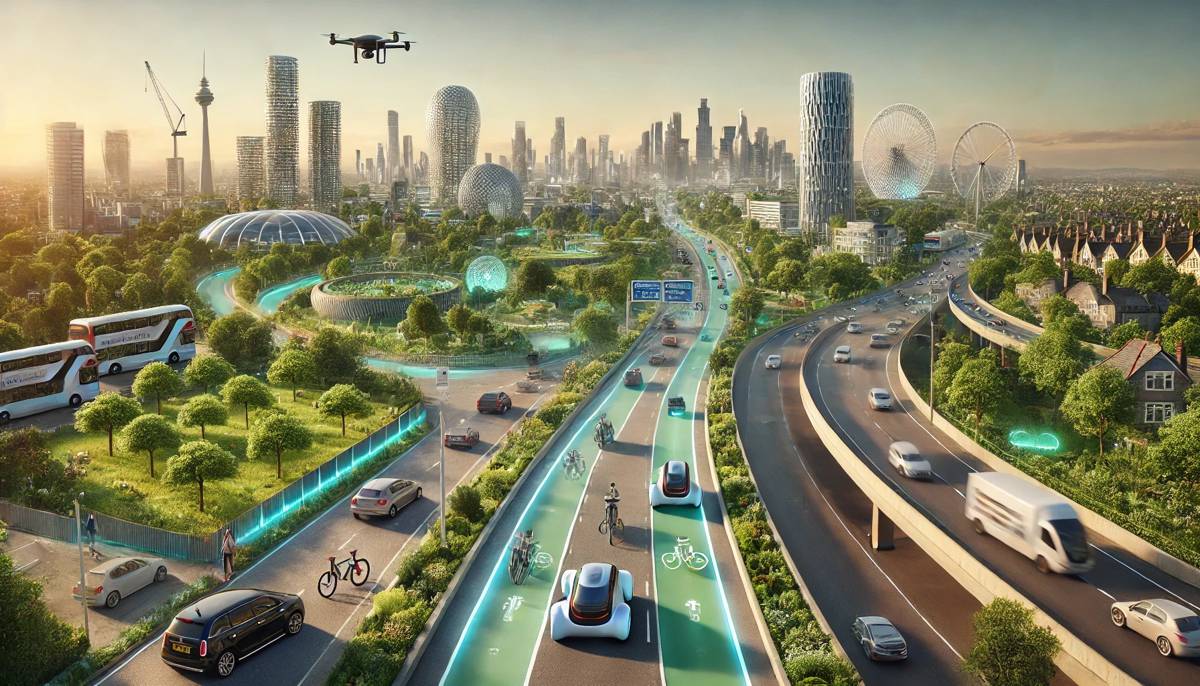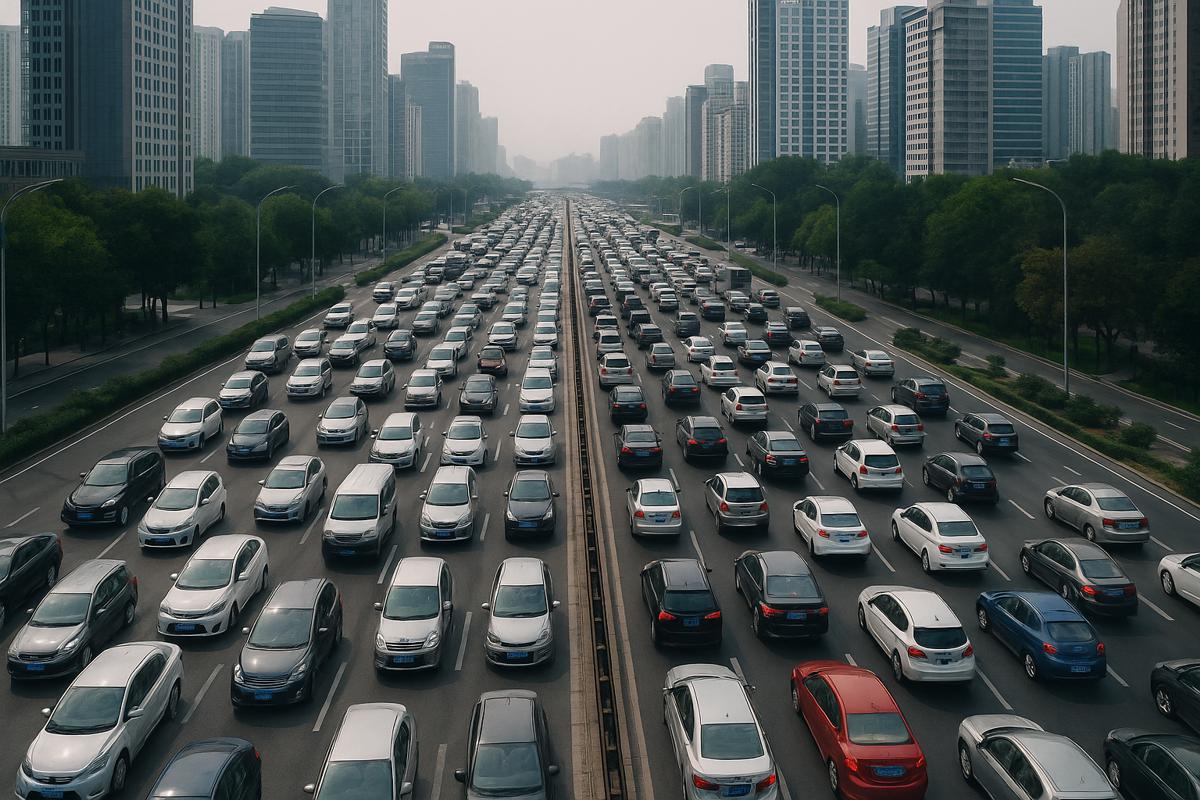Reimagining UK Roads with AI for a Greener Future
The UK is consistently looking to the future of road travel, making progress on the government’s 2021 decarbonisation plan, titled A Better, Greener Britain. So far, 95% of the National Highways network is within 20 miles of an electric car charging point and National Highways has completed 150 cycleway schemes.
In 2022/23, £4.5 billion was spent on UK roads – preluding the “biggest-ever” road resurfacing programme announced to tackle potholes, totalling £8.3 billion of allocated funds. A total of 4.4 million claims were made by drivers in 2023 over pothole-related incidents, which got us thinking about how the roads of the future will help make driving as efficient, comfortable and safe as possible for drivers.
With AI technology coming on in leaps and bounds over the last year, especially with the recent release of ChatGPT 4.0, we thought we’d ask AI for its sci-fi predictions on the future of UK roads.
Richard Moss, Head of Civils at Instarmac, who manufacture and distribute road surfacing materials and other cement and bitumen based products, comments on AI’s suggestions – revealing a fine line between mad and mad genius.
Autonomous vehicles integration
Autonomous or “self-driving” cars used to be a quaint thought, more closely associated with something out of Blade Runner than a real-life possibility. That being said, come 2024, autonomous vehicle applications are starting to look less and less far-fetched.
April 2024 saw a driverless car built by the Technical University of Munich win the Abu Dhabi Autonomous Racing League. The Kia EV6 offers complete driverless parking, without the driver needing to be inside the vehicle to operate and Google’s Waymo is currently operating driverless taxis in Phoenix, San Francisco and LA.
It’s no surprise then that AI thinks autonomous vehicle integration will play a huge role in the future of UK road infrastructure. AI states: “UK roads may see a gradual transition towards autonomous features, such as lane-keeping assistance and adaptive cruise control, leading to fully autonomous vehicles in certain areas or dedicated lanes on UK roads.”
When asked, Richard Moss commented: “It’s an incredible thought, isn’t it? That being said, I think it’s ambitious to see this sort of infrastructure implemented in the near future,” he says. “There’s been lots of back and forth regarding autonomous vehicles, with the hype often outweighing the progress made on making them a reality for everyday drivers. Renault recently abandoned its autonomous driving ambitions for cars, instead shifting to minibuses, for example. “We also have to ask – where is the appetite for driverless cars? Some features like lane assist and preventative crashing are brilliant, but removing human autonomy behind the wheel also removes the fun of driving itself,” he continues. “Before dedicated driverless lanes, we would have to make sure there are enough dedicated charging stations available to keep up with the demand.”
Adaptive and resilient design
AI is also concerned with the effect of climate change on our road surfaces themselves. It isn’t misguided to be concerned about intense weather and rising road users – the climate is getting warmer every decade and UK road traffic increased by 8.8% between 2021 and 2022.
So, what does AI think the solution is?
“Infrastructure may need to be built or retrofitted to withstand extreme weather events, such as floods and heat waves,” says AI. “This may include investments in technologies like self-healing materials, drones for inspection and maintenance, and predictive analytics to identify potential failures before they occur, ensuring the reliability and longevity of UK roads.”
Richard sees some merit in this prediction, stating:
“It’s right to show concern and AI might not be too far off the mark here. We are seeing incredible applications of self-healing materials already, especially in concrete. Self-healing concrete made with superabsorbent polymers encourages autogenous repair and self-sensing concrete can detect stress and strain within itself,” Richard explains. “This technology is perfectly positioned to improve long-term road use for heavy goods vehicles and high traffic areas.
“Drone use to detect issues, however, I am unsure of. If you ask me, you can’t beat the knowledge of a trained professional; seeing the problem with your own eyes is the best way to find a solution. We also already have a network detecting road issues – it’s called the general public! The 4.4 million reports of potholes to the government are a reminder of that.”
Underground transportation networks
Air pollution from towns and cities is a serious issue, with the University of Oxford finding it costs the UK £6 billion in health costs per year. With projections that we could see two billion cars on the road by 2040, is moving roads underground to lower pollution and ease congestion the answer? AI seems to think so: “To alleviate surface congestion and preserve urban space, the future of UK roads might extend underground. Underground transportation networks, such as tunnels or subterranean highways, could provide efficient and environmentally friendly alternatives for both passenger and freight transport, seamlessly connecting cities and regions.”
Underground transportation isn’t completely unheard of – the London Underground, anyone? The first underground tunnel in London, The Metropolitan Line, was built in 1863. Since then, demand for more underground transportation has only increased. Most recently we witnessed the release of the Elizabeth Line in 2022, further adding to the complex London Underground train network.
Richard had this to say about moving roads underground: “Underground roads would be fantastic for freeing up space. There is approximately 245 thousand miles of road in the UK, and if moved underground, that space could be converted into housing, parks, community centres – even whole towns!” he explains.
“Where I pause is in regard to safety and freedom of movement on our roads,” he continues. “Anyone that has driven through a long stretch of tunnel knows how dangerous dark long stretches of road can be – you have to remain very alert. If the entirety of our roads were underground, emergency services may struggle to reach users. I can foresee difficulties in reaching your destination accurately, playing a guessing game with what’s above you on the surface. In addition, it’d make driving miserable – no one wants to drive for hours in a tunnel with no scenery! A whole host of logistics would have to be carefully thought out before this was put into effect.”
Hyper-Connected Cities
Going out with a bang – we’ve turned it up a notch, asking AI what it thinks the state of UK roads will be in a thousand years.
Unsurprisingly, the concept is a bit out there. Star Wars fans will be very familiar with the concept of a hyper-connected city, think Coruscant – a planet which is essentially one giant city connected by a never-ending road network. AI says: “The concept of cities may evolve into hyper-connected megastructures, where buildings, roads, and infrastructure are seamlessly integrated into a single cohesive system. Autonomous vehicles, drones, and high-speed transit systems would coexist within a unified transportation ecosystem, offering efficient and flexible mobility options for residents. Advanced routing algorithms would optimise travel routes in real-time, reducing congestion and travel times.”
“I can’t decide if this sounds impressive or terrifying!” Richard laughs. “There’s a lot to love about increased connectivity and reduced travel times. We’re seeing great transport integration already here and abroad: the London Underground is a technical marvel, trams have their charm and the Japanese Bullet Train has revolutionised high-speed travel. That being said, it’d be upsetting to lose our beautiful country roads and the individual identities of our towns and cities.
“In a thousand years, maybe we will see these megacities as the population increases and technology matures. For now, I’m going to have a newfound appreciation for our rolling countryside. Enjoy it while we can!”




















